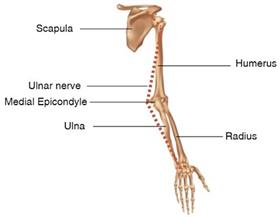What Does Soreness at the Funny Bone Indicate
Ever smacked your elbow on a spot often called the funny bone and felt sharp pain shooting down your forearm? Well unless you are a masochist or just weird, it's unlikely you'll laugh or find it funny.
Jokes aside, the funny bone (a silly name apparently derived from its close proximity to the humerus bone) is not even a bone. It's actually one of the major nerves in your arm and hand called the ulnar nerve, explains medical physiologist at Stellenbosch University's Faculty of Medical and Health Sciences Dr Derick van Vuuren.
He points out that the ulnar nerve leads out of the spinal cord in your neck and moves to the shoulder. It then continues down the inner upper arm, casing the elbow joint as it travels down the forearm, before ending in the ring and small fingers of your hand. The funny bone runs under a bony extension of the long humerus bone that forms your upper arm called the medial epicondyle.
For most of its length, bones, tissues and muscle conceal the ulnar nerve. Where it passes through your elbow joint, there is only a thin layer of skin, making it much more vulnerable to knocks.
"When you experience a quick bump to this nerve, it sends a barrage of signals to the brain, which cause a shock-like tingling sensation down its length that you experience as numbness or extreme pain in the arm and outer fingers," explains Dr van Vuuren.
Fortunately, the numbing discomfort that follows usually only lasts a couple of minutes. What makes this specific section of the nerve so sensitive, he adds, has nothing to do with the nerve itself, but rather with its positioning. The painful jolt after a knock to the funny bone that doctors call an ulnar nerve contusion is because you are actually hitting the nerve and compressing it against the bone.
What does the ulnar do?
A knock to the funny bone does more than justify yelling expletives as the ulnar nerve plays a key role in function and coordination. Aside from controlling most of the small muscles in your hand and wrist that coordinate fine movements, it controls sensation in the small and ring fingers and directs bigger forearm muscles so you can grip something strongly, says the American Academy of Orthopaedic Surgeons (AAOS).
When funny bone pain persists
Sometimes transient funny bone pain is not simply because you suddenly whacked your elbow against the bar counter while out socialising with your friends. Persistent elbow pain might signal a chronic condition known as cubital tunnel syndrome.
This painful condition according to the American Society for Surgery of the Hand (ASSH) website, may occur if you repeatedly bend your elbow, lean on an arm rest or keep it bent for long periods (for example, while sleeping or talking on your cell phone for ages).
Also called "tennis elbow" or "golfer's elbow," ASSH says cubital tunnel syndrome happens when repetitive pressure or stretching of the ulnar nerve causes an obstruction somewhere along its path near the elbow, or when you injure your elbow or forearm muscle.
The good news though, is that it is very treatable. Anti-inflammatory medication, elbow splinting or corrective arm posturing exercises prescribed by a physiotherapist usually do the trick.
It's ok to laugh it off if you sometimes bump your funny bone. However, if ongoing elbow pain is no longer a joke, or if you experience more than the occasional feeling of tingling, numbness or weakness in your arm, hand or fingers, see your doctor.
Treating cubital tunnel syndrome
The American Society for Surgery of the Hand (ASSH) gives these tips on treating cubital tunnel syndrome:
- Avoid elbow actions that cause painful symptoms
- Try wrapping a towel loosely around your elbow at night to prevent it from bending
- Don't routinely lean on your funny bone. If you can't avoid this, try placing a cushion or pillow on the hard surface to cushion your elbow
- Ask a physiotherapist for some advice on exercises to avoid pressure on your ulnar nerve.
Read more:
Why do we get pins and needles?
10 Fun facts about the nervous system
How does the body respond to touching something hot?
Sources
1. http://www.livescience.com/33727-pins-needles-sensation.html
2. http://www.assh.org/handcare/hand-arm-conditions/cubital-tunnel
3. https://sites.psu.edu/siowfa15/2015/09/06/why-hitting-your-funny-bone-isnt-funny/
4. http://orthoinfo.aaos.org/topic.cfm?topic=a00069
Source: https://www.news24.com/health24/lifestyle/healthy-nerves/why-bumping-your-funny-bone-hurts-so-much-20160317

0 Response to "What Does Soreness at the Funny Bone Indicate"
Postar um comentário